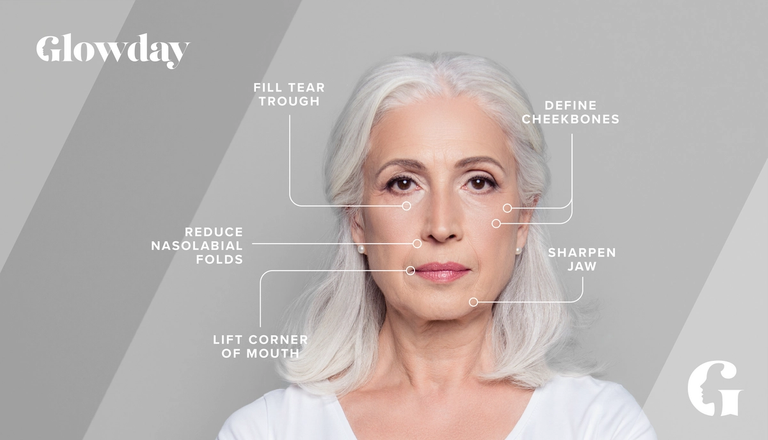
The best non-surgical facelifts in Neath
We only feature the best non-surgical facelift practitioners near you who we have vetted to ensure that they’re medically qualified, trained and insured. Click on their profile to read their real patients' reviews and to see their before and after photos.
At A Glance
Top Questions
Non-surgical liquid facelift - Overview
As we age, the reduction in facial fat pads and in the production of collagen and elastin leads to skin losing it’s elasticity and plumpness.
Typically, people begin to notice this in their late 30s. Skin begins to sag, the under-eye area looks tired and the jawline loosens as jowls begin to form.
The non-surgical face lift uses a minimal amount of strategically placed hyaluronic acid fillers to replace the volume lost from parts of the face which result in this sagging and loosening. The result is very subtle, giving an overall rejuvenating and refreshing change to the face.
There are over 60 brands of dermal filler available in the UK. The most commonly used are made from hyaluronic acid which is well tolerated and easily dissolved should there be any problems.
Some of the most commonly used hyaluronic acid fillers are:
Restylane®, Juvéderm®, Belotero® and Teosyal®
Practitioners will likely use a range of brands for different treatments, based on their knowledge and experience. Different hyaluronic acid products have different viscosities. More gel-like products will be chosen for sculpting and adding volume.
During the liquid facelift, small volumes of filler are injected into the skin in up to 8 specific areas on each side of the face. This replaces lost volume due to a reduction in facial fat pads and collagen.
This Glowday Treatment Guide has been edited and medically verified by Andrew Rankin.
How do liquid facelifts work?
The leading dermal fillers used by most UK practitioners are hyaluronic acid-based products. Hyaluronic acid is a naturally occurring substance within the body, which makes adverse reactions to it unlikely.
When injected into the skin, hyaluronic acid instantly fills out hollow areas, adding volume and shape where necessary
The 8 point approach is one technique associated with the Juvéderm® brand of fillers many practitioners use to achieve this liquid facelift. As the name suggests, the 8-point facelift involves injecting filler into 8 strategic ‘lifting points’ as shown in the diagram below:

Cheek bone: A small amount of filler here enhances the cheekbone and helps reduce nasolabial folds.
Tear trough/midface: Reduces tired, hollow eyes.
Nasolabial folds: This often deepens with age. You may or may not need additional filler here if filler in 1 & 2 has lifted the folds sufficiently.
Mouth corners: A small amount of filler here can lift a downturned mouth.
Pre-jowl: Loss of volume in the chin, jaw and cheek can all lead to the formation of jowls. Adding volume here will help reduce jowls.
Jawline: As we age, the jaw loses it’s definition and squareness. Volume added here firms up the jawline.
Lower cheek: Filler here can help maintain a natural curve and structure to the cheek.
Depending on the degree of volume replacement needed, you may not need filler injected into each of the 8 points. Your practitioner will be able to advise on the best procedure for you.
The liquid facelift requires expert knowledge of the anatomy of the face, the underlying nerves and blood vessels. This is not a procedure you want carried out by a non-medically qualified practitioner. It is imperative that you choose a medically qualified, experienced practitioner to treat you.
Who are liquid facelifts good for?
Hyaluronic acid-based fillers can be used on adults of any genders. They are suitable for those who have noticed skin sagging, jowls and under-eye bags forming and darkening, typically those in their late 30s upwards.
Those who have more severe skin laxity may require more filler and possibly different techniques.
How do you prepare for a liquid facelift?
In the week before the treatment, avoid taking aspirin, ibuprofen, vitamin E and fish oil supplements as these may increase bleeding and bruising.
You can take paracetamol.
What happens during a liquid facelift treatment?
What happens after a liquid facelift?
After your treatment, you can go about your normal day.
Post-treatment advice may include:
- iced water soaks or ice packs to help to reduce swelling (although this is generally not required);
- the use of pain-killers such as paracetamol, is often not required but may be used if needed for a few days after treatment;
- arnica (a homeopathic remedy) cream or tablets are sometimes recommended a few days before and a few days after treatment as there is some evidence that this can reduce bruising.
Bruising and swelling should go down after a couple of days but can persist for a week.
If you continue to experience excessive swelling, pain, skin colour changes or if any blistering occurs, you should contact your practitioner immediately.
Similarly, if you experience any delayed reactions such as lumpy redness occurring any time after treatment, you should contact the person who treated you immediately.
What are the side effects and risks of liquid facelifts?
Depending on the area being injected, the type of filler and the pain relief method being used, clients may find this procedure relatively painless to uncomfortable. Treatments around the nose and lips are usually more painful than other areas but most clients find filler treatments bearable.
You must discuss pain management options with your practitioner and let them know if you are finding the procedure too uncomfortable.
The obvious, immediate and most common side effect is slight bleeding after the needle has been inserted into the skin.
Other risks include bruising, tenderness, redness and swelling around the injection site. These signs may take 2-3 days to vanish completely, especially around the lips where there is little flesh and skin is tender.
Occasionally, a ‘bleb’ will occur. This is where the filler has been injected too superficially (close to the surface) and will need to be dissolved.
Rarely, allergic type reactions can occur after a filler treatment. These include prolonged redness, swelling, itching and/or hardness and bumps in the skin. Such signs may appear at some or all injection points. Sometimes, they can last several months or longer, but this is extremely unusual.
Another rare side effect is occlusions. This is where filler is accidentally injected into a blood vessel, creating a blockage. This presents as a whitening of the skin, followed by the area turning greyish-purple. If left untreated, this can result in tissue loss in the affected area. There have been reports of this in lip and nose treatments.
One particular type of occlusion is an ocular occlusion. This is where a blood vessel supplying the eye gets blocked. This results in partial or complete blindness.
Obviously, if you exhibit any symptoms of occlusion, you need to seek the advice of your practitioner and/or visit accident and emergency immediately.
You will need to be prescribed emergency treatment medicines, which is why it is important that you have access to a practitioner who is able to prescribe medicine.
As with any skin treatment, injections should be avoided in areas where the skin is swollen or where infections are present - e.g. active acne.
If you have a history of cold sores, or fever blisters in the treated area, filler injections may cause them to break out. In these cases, your practitioner may recommend that you take a course of anti-viral medicine before treatment to help reduce the likelihood of an outbreak.
If you have a known allergy to hyaluronic fillers or any of the ingredients in the filler product, you must inform your practitioner. An alternative treatment will need to be carried out.
Dermal fillers have not been tested on pregnant women. No medically qualified practitioner would carry out a filler treatment on a pregnant woman.
How much does a liquid facelift cost?
Costs vary depending mostly on the type of dermal filler used, the area of the face to be filled and the degree of filling to the skin required.
Generally prices for dermal fillers are based upon the estimated number of syringes needed to obtain the required result. For the liquid facelift, on average, between 2 and 4 syringes are required.
Typically, the types of fillers used more for facial sculpting, contouring and addition of volume will tend to be more expensive than those just used for treating single lines.
A combination of fillers may also be recommended, and for certain areas additional treatments with other agents such as botulinum toxin (Botox®) may also be suggested (especially for lines in the upper part of the face).
In addition, different filler brands such as Restylane®, Perlane®, Radiesse® and Juvederm® differ in price to clinics and practitioners who purchase them from the respective manufacturers.
Hence, overall prices may vary from £650 to over £950 for a liquid facelift.
Remember, using less filler than is actually required to fill out a line or improve the contour of the face properly will generally produce a less pleasing, shorter-lasting effect than opting for a proper (and more expensive) treatment.